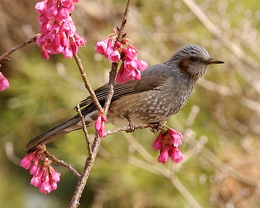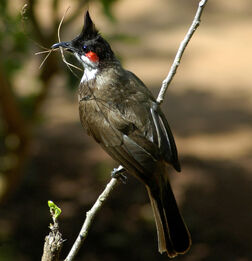| Bulbuls | |
|---|---|

| |
| Brown-eared Bulbul, Microscelis amaurotis | |
| Scientific classification | |
| Kingdom: | Animalia |
| Phylum: | Chordata |
| Class: | Aves |
| Clade: | Inopinaves |
| Order: | Passeriformes |
| Suborder: | Passeri |
| Superfamily: | Sylvioidea |
| Clade: | Swallow clade |
| Family: | Pycnonotidae G. R. Gray, 1840 |
| Genera | |
|
See text. | |
| Synonyms | |
|
Brachypodidae Swainson, 1831 | |
Bulbuls are a family, Pycnonotidae, of medium-sized passerine songbirds. Many forest species are known as greenbuls. The family is distributed across most of Africa and into the Middle East, tropical Asia to Indonesia, and north as far as Japan. A few insular species occur on the tropical islands of the Indian Ocean There are about 130 species in around 24 genera. While some species are found in most habitats, overall African species are predominately found in rainforest whilst rainforest species are rare in Asia, instead preferring more open areas. The only Bulbul which occurs in Europe was spotted in the Cyclades and bears a yellow patch, being otherwise of a snuffy brown and this is possibly the bird which has got mixed up with the nightingale in Sufi, particularly Persian Sufi, poetry.
Description[]
Bulbuls are short-necked slender passerines. The tails are long and the wings short and rounded. In almost all species the bill is slightly elongated and slightly hooked at the end. They vary in length from 13 cm for the Tiny Greenbul to 29 cm in the Straw-headed Bulbul. Overall the sexes are alike, although the females tend to be slightly smaller. In a few species the differences are so great that they have been described as functionally different species. The soft plumage of some species is colourful with yellow, red or orange vents, cheeks, throat or supercilia, but most are drab, with uniform olive brown to black plumage. Species with dull coloured eyes often sport contrasting eyerings. Some have very distinct crests. Bulbuls are highly vocal, with the calls of most species being described as nasal or gravelly. One author described the song of the Brown-eared Bulbul as "the most unattractive noises made by any bird".[1]
Bulbuls eat a wide range of different foods, ranging from fruit to seeds, nectar, small insects and other arthropods and even small vertebrates. The majority of species are frugivorous and supplement their diet with some insects, whilst there is a significant minority of specialists, particularly in Africa. Open country species in particular are generalists. Bulbuls in the genus Criniger and bristlebills in the genus Bleda will join mixed-species feeding flocks.
The bulbuls are generally monogamous. One unusual exception is the Yellow-whiskered Greenbul which at least over part of its range appears to be polygamous and engage in a lekking system. Some species also have alloparenting arrangements, where non-breeders, usually the young from earlier clutches, help raise the young of a dominant breeding pair. Up to five purple-pink eggs are laid in an open tree nests and incubated by the female. Incubation usually lasts between 11–14 days , and chicks fledge after 12–16 days.
Relationship to humans[]
The Red-whiskered Bulbuls and Red-vented Bulbuls have been captured for the pet trade in great numbers and, has been widely introduced to tropical and subtropical areas, for example southern Florida, Fiji, Australia and Hawaii. Some species are regarded as crop pests, particularly in orchards.
In general bulbuls and greenbuls are resistant to human pressures on the environment and are tolerant of disturbed habitat. Around 13 species are considered threatened by human activities, mostly specialised forest species threatened by habitat loss.
Etymology[]
The word bulbul derives from Template:Lang-fa bolbol, meaning nightingale.[1]
Systematics[]
The traditional layout was to divide the bulbuls into 4 groups, named Pycnonotus, Phyllastrephus, Criniger, and Chlorocichla groups after characteristic genera (Delacour, 1943). However, more recent analyses demonstrated that this arrangement was probably based on erroneous interpretation of characters:
Comparison of mtDNA cytochrome b sequences found that five species of Phyllastrephus did not belong to the bulbuls, but to an enigmatic group of songbirds from Madagascar instead (Cibois et al., 2001; see below for the species in question). Similarly, sequence analysis of the nDNA RAG1 and RAG2 genes suggests that the genus Nicator is not a bulbul either (Beresford et al., 2005). That the previous arrangement had failed to take into account biogeography was indicated by the study of Pasquet et al. (2001) who demonstrated the genus Criniger must be divided into an African and an Asian (Alophoixus) lineage. Using analysis of one nDNA and 2 mtDNA sequences, Moyle & Marks (2006) found one largely Asian lineage and one African group of greenbuls and bristlebills; the Golden Greenbul seemes to be very distinct and form a group of its own. Some taxa are not monophyletic, and more research is necessary to determine relationships within the larger genera.
Systematic list[]
Basal
- Genus Calyptocichla
- Golden Greenbul, Calyptocichla serina
Typical bulbuls

The Red-whiskered Bulbul belongs to the Asian Pycnonotus.
- Genus Pycnonotus (paraphyletic)
- "Ancient" Asian bulbuls
- Black-headed Bulbul, Pycnonotus atriceps
- Stripe-throated Bulbul, Pycnonotus finlaysoni
- Red-whiskered Bulbul, Pycnonotus jocosus
- Brown-breasted Bulbul, Pycnonotus xanthorrhous
- Puff-backed Bulbul, Pycnonotus eutilotus
- Black-and-white Bulbul, Pycnonotus melanoleucus
- Pycnonotus proper
- Black-crested Bulbul, Pycnonotus melanicterus
- Grey-bellied Bulbul, Pycnonotus cyaniventris
- Spectacled Bulbul, Pycnonotus erythropthalmos
- Straw-headed Bulbul, Pycnonotus zeylanicus
- Red-eyed Bulbul, Pycnonotus brunneus
- Olive-winged Bulbul, Pycnonotus plumosus
- Yellow-vented Bulbul, Pycnonotus goiavier
- Black-fronted Bulbul, Pycnonotus nigricans
- White-cheeked Bulbul, Pycnonotus leucogenys
- Disputed
- Common Bulbul, Pycnonotus barbatus
- Unassigned
- Striated Bulbul, Pycnonotus striatus
- Cream-striped Bulbul, Pycnonotus leucogrammicus
- Spot-necked Bulbul, Pycnonotus tympanistrigus
- Grey-headed Bulbul, Pycnonotus priocephalus
- Styan's Bulbul, Pycnonotus taivanus
- Scaly-breasted Bulbul, Pycnonotus squamatus
- Light-vented Bulbul, Pycnonotus sinensis
- Cape Bulbul, Pycnonotus capensis (type species)
- White-spectacled Bulbul, Pycnonotus xanthopygos
- White-eared Bulbul, Pycnonotus leucotis
- Red-vented Bulbul, Pycnonotus cafer
- Sooty-headed Bulbul, Pycnonotus aurigaster
- Blue-wattled Bulbul, Pycnonotus nieuwenhuisii (disputed)
- Yellow-wattled Bulbul, Pycnonotus urostictus
- Orange-spotted Bulbul, Pycnonotus bimaculatus
- Yellow-throated Bulbul, Pycnonotus xantholaemus
- Yellow-eared Bulbul, Pycnonotus penicillatus
- Flavescent Bulbul, Pycnonotus flavescens
- White-browed Bulbul, Pycnonotus luteolus
- Streak-eared Bulbul, Pycnonotus blanfordi
- Cream-vented Bulbul, Pycnonotus simplex
- Bare-faced Bulbul, Pycnonotus hualon
Collared Finchbill, Spizixos semitorques
- Genus Spizixos – finchbills (2 species)
- Crested Finchbill, Spizixos canifrons
- Collared Finchbill, Spizixos semitorques
- Genus Tricholestes – Hairy-backed Bulbul
- Genus Setornis – Hook-billed Bulbul
- Genus Alophoixus (formerly in Criniger, possibly polyphyletic)
- Finsch's Bulbul, Alophoixus finschii
- White-throated Bulbul, Alophoixus flaveolus
- Puff-throated Bulbul, Alophoixus pallidus
- Ochraceous Bulbul, Alophoixus ochraceus
- Gray-cheeked Bulbul, Alophoixus bres
- Yellow-bellied Bulbul, Alophoixus phaeocephalus
- Golden Bulbul, Alophoixus affinis
- Genus Iole (4 species, sometimes in Hypsipetes/Ixos)
- Genus Hemixos (2 species, sometimes in Hypsipetes/Ixos)
- Genus Ixos (paraphyletic, might include Hypsipetes)
- Close to Hemixos
- Streaked Bulbul, Ixos malaccensis
- Unassigned
- Sulphur-bellied Bulbul, Ixos palawanensis (Hypsipetes?)
- Streak-breasted Bulbul, Ixos siquijorensis (Hypsipetes?)
- Zamboanga Bulbul, Ixos rufigularis (Hypsipetes?)
- Yellowish Bulbul, Ixos everetti
- Mountain Bulbul, Ixos mcclellandii
- Sunda Bulbul, Ixos virescens
- Genus Microscelis – Brown-eared Bulbul (sometimes in Hypsipetes/Ixos)
- Genus Hypsipetes (9–10 species, might belong in Ixos)
Typical greenbuls and allies
- Genus Phyllastrephus (19 species)
- Genus Andropadus (12 species; possibly polyphyletic)
- Genus Criniger (5 species)
- Genus Thescelocichla – Swamp Greenbul
- Genus Chlorocichla (6 species)
- Genus Ixonotus – Spotted Greenbul (tentatively placed here)
- Genus Baeopogon (2 species)
- Genus Bleda – bristlebills (3 species)
Incertae sedis
- Genus Neolestes
- Black-collared Bulbul, Neolestes torquatus
This might be allied to Calyptocichla or not be a bulbul at all.
Recently split from Pycnonotidae[]
The Long-billed Greenbul of Madagascar is now considered to be a Malagasy warbler.
Now in Malagasy warblers
- Genus Bernieria – formerly in Phyllastrephus
- Long-billed Greenbul, Bernieria madagascariensis
- Genus Xanthomixis – formerly in Phyllastrephus; possibly polyphyletic
- Spectacled Greenbul, Xanthomixis zosterops
- Appert's Greenbul, Xanthomixis apperti
- Dusky Greenbul, Xanthomixis tenebrosus
- Gray-crowned Greenbul, Xanthomixis cinereiceps
Incertae sedis
- Genus Nicator
- Yellow-spotted Nicator, Nicator chloris
- Eastern Nicator, Nicator gularis
- Yellow-throated Nicator, Nicator vireo
References[]
- Beresford, P.; Barker, F.K.; Ryan, P.G. & Crowe, T.M. (2005): African endemics span the tree of songbirds (Passeri): molecular systematics of several evolutionary 'enigmas'. Proc. Roy. Soc. Lond. B 272(1565): 849–858. doi:10.1098/rspb.2004.2997 PDF fulltext Electronic appendix
- Cibois, Alice; Slikas, Beth; Schulenberg, Thomas S. & Pasquet, Eric (2001): An endemic radiation of Malagasy songbirds is revealed by mitochondrial DNA sequence data. Evolution 55(6): 1198–1206. DOI:10.1554/0014-3820(2001)055[1198:AEROMS]2.0.CO;2 PDF fulltext
- Delacour, J. (1943): A revision of the genera and species of the family Pycnonotidae (bulbuls). Zoologica 28(1): 17–28.
- Fishpool L. & Tobias J. (2005) "Family Pycnonotidae (Bulbuls) in del Hoyo, J.; Elliot, A. & Christie D. (editors). (2005). Handbook of the Birds of the World. Volume 10: Cuckoo-Shrikes to Thrushes. Lynx Edicions. ISBN 8487334725
- Moyle, Robert G. & Marks, Ben D. (2006): Phylogenetic relationships of the bulbuls (Aves: Pycnonotidae) based on mitochondrial and nuclear DNA sequence data. Molecular Phylogenetics and Evolution 40(3): Pages 687–695. doi:10.1016/j.ympev.2006.04.015 (HTML abstract)
- Pasquet, Éric; Han, Lian-Xian; Khobkhet, Obhas & Cibois, Alice (2001): Towards a molecular systematics of the genus Criniger, and a preliminary phylogeny of the bulbuls (Aves, Passeriformes, Pycnonotidae). Zoosystema 23(4): 857–863. PDF fulltext
Notes[]
External links[]
| Wikimedia Commons has media related to: http://commons.wikimedia.org/wiki/Category:Pycnonotidae |
- Bulbul photos and videos on the Internet Bird Collection
- Family characters

|
This article is part of Project Bird Taxonomy, a All Birds project that aims to write comprehensive articles on every order, family and other taxonomic rank related to birds. |

|
This article is part of Project Bird Families, a All Birds project that aims to write comprehensive articles on each bird family, including made-up families. |
| This page uses Creative Commons Licensed content from Wikipedia (view authors). Please help by writing it in the style of All Birds Wiki! |
